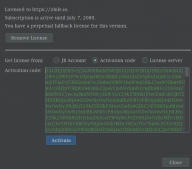有时候,我们需要将TensorFlow的模型导出为单个文件(同时包含模型架构定义与权重),方便在其他地方使用(如在c++中部署网络)。利用tf.train.write_graph()默认情况下只导出了网络的定义(没有权重),而利用tf.train.Saver().save()导出的文件graph_def与权重是分离的,因此需要采用别的方法。
我们知道,graph_def文件中没有包含网络中的Variable值(通常情况存储了权重),但是却包含了constant值,所以如果我们能把Variable转换为constant,即可达到使用一个文件同时存储网络架构与权重的目标。
我们可以采用以下方式冻结权重并保存网络:
|
1
2
3
4
5
6
7
8
9
10
11
12
13
14
15
|
import tensorflow as tffrom tensorflow.python.framework.graph_util import convert_variables_to_constants# 构造网络a = tf.Variable([[3],[4]], dtype=tf.float32, name='a')b = tf.Variable(4, dtype=tf.float32, name='b')# 一定要给输出tensor取一个名字!!output = tf.add(a, b, name='out')# 转换Variable为constant,并将网络写入到文件with tf.Session() as sess: sess.run(tf.global_variables_initializer()) # 这里需要填入输出tensor的名字 graph = convert_variables_to_constants(sess, sess.graph_def, ["out"]) tf.train.write_graph(graph, '.', 'graph.pb', as_text=False) |
当恢复网络时,可以使用如下方式:
|
1
2
3
4
5
6
7
|
import tensorflow as tfwith tf.Session() as sess: with open('./graph.pb', 'rb') as f: graph_def = tf.GraphDef() graph_def.ParseFromString(f.read()) output = tf.import_graph_def(graph_def, return_elements=['out:0']) print(sess.run(output)) |
输出结果为:
[array([[ 7.],
[ 8.]], dtype=float32)]
可以看到之前的权重确实保存了下来!!
问题来了,我们的网络需要能有一个输入自定义数据的接口啊!不然这玩意有什么用。。别急,当然有办法。
|
1
2
3
4
5
6
7
8
9
10
11
|
import tensorflow as tffrom tensorflow.python.framework.graph_util import convert_variables_to_constantsa = tf.Variable([[3],[4]], dtype=tf.float32, name='a')b = tf.Variable(4, dtype=tf.float32, name='b')input_tensor = tf.placeholder(tf.float32, name='input')output = tf.add((a+b), input_tensor, name='out')with tf.Session() as sess: sess.run(tf.global_variables_initializer()) graph = convert_variables_to_constants(sess, sess.graph_def, ["out"]) tf.train.write_graph(graph, '.', 'graph.pb', as_text=False) |
用上述代码重新保存网络至graph.pb,这次我们有了一个输入placeholder,下面来看看怎么恢复网络并输入自定义数据。
|
1
2
3
4
5
6
7
8
|
import tensorflow as tfwith tf.Session() as sess: with open('./graph.pb', 'rb') as f: graph_def = tf.GraphDef() graph_def.ParseFromString(f.read()) output = tf.import_graph_def(graph_def, input_map={'input:0':4.}, return_elements=['out:0'], name='a') print(sess.run(output)) |
输出结果为:
[array([[ 11.],
[ 12.]], dtype=float32)]
可以看到结果没有问题,当然在input_map那里可以替换为新的自定义的placeholder,如下所示:
|
1
2
3
4
5
6
7
8
9
10
|
import tensorflow as tfnew_input = tf.placeholder(tf.float32, shape=())with tf.Session() as sess: with open('./graph.pb', 'rb') as f: graph_def = tf.GraphDef() graph_def.ParseFromString(f.read()) output = tf.import_graph_def(graph_def, input_map={'input:0':new_input}, return_elements=['out:0'], name='a') print(sess.run(output, feed_dict={new_input:4})) |
看看输出,同样没有问题。
[array([[ 11.],
[ 12.]], dtype=float32)]
另外需要说明的一点是,在利用tf.train.write_graph写网络架构的时候,如果令as_text=True了,则在导入网络的时候,需要做一点小修改。
|
1
2
3
4
5
6
7
8
9
10
11
|
import tensorflow as tffrom google.protobuf import text_formatwith tf.Session() as sess: # 不使用'rb'模式 with open('./graph.pb', 'r') as f: graph_def = tf.GraphDef() # 不使用graph_def.ParseFromString(f.read()) text_format.Merge(f.read(), graph_def) output = tf.import_graph_def(graph_def, return_elements=['out:0']) print(sess.run(output)) |
参考资料
Is there an example on how to generate protobuf files holding trained Tensorflow graphs
以上就是本文的全部内容,希望对大家的学习有所帮助,也希望大家多多支持服务器之家。
原文链接:https://blog.csdn.net/encodets/article/details/54428456





